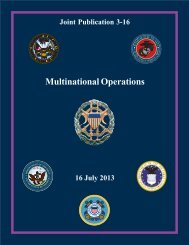ABUSE OF STRUCTURED FINANCIAL PRODUCTS- Misusing Basket Options to Avoid Taxes and Leverage Limits MAJORITY AND MINORITY STAFF REPORT
ABUSE OF STRUCTURED FINANCIAL PRODUCTS- Misusing Basket Options to Avoid Taxes and Leverage Limits MAJORITY AND MINORITY STAFF REPORT
ABUSE OF STRUCTURED FINANCIAL PRODUCTS- Misusing Basket Options to Avoid Taxes and Leverage Limits MAJORITY AND MINORITY STAFF REPORT
Create successful ePaper yourself
Turn your PDF publications into a flip-book with our unique Google optimized e-Paper software.
41<br />
the trades were placed <strong>and</strong> executed by computer from RenTec’s facilities, using its algorithms<br />
<strong>to</strong> initiate <strong>and</strong> execute the trades through the bank’s proprietary trading software. The trades<br />
were typically executed with no human intervention on either side, except when RenTec<br />
personnel adjusted the algorithm parameters. 242 The executed positions were held in the<br />
designated option accounts in the name of Palomino <strong>and</strong> were immediately reported <strong>to</strong><br />
Barclays. 243 All positions were reconciled daily for both Barclays <strong>and</strong> RenTec. 244<br />
The value of the COLT options was linked <strong>to</strong> the performance of the assets held in the<br />
designated accounts, consisting of all trading positions resulting from executions made by<br />
RenTec for those accounts. 245 The options included a commitment by Barclays <strong>to</strong> provide<br />
financing for the accounts that, based upon the amount of the initial premium provided by<br />
Badger, could reach a leverage level of up <strong>to</strong> 20:1. 246 Because all marketable trade orders made<br />
by RenTec were immediately executed <strong>and</strong> the assets assigned <strong>to</strong> the designated accounts, those<br />
accounts also were described in documents <strong>and</strong> by Barclays personnel as providing a hedge for<br />
Palomino <strong>and</strong>, ultimately, for Barclays.<br />
Under the Investment Management Agreement, if the value of the referenced assets in the<br />
designated accounts were <strong>to</strong> fall by an amount equal <strong>to</strong> the premium provided by Badger, the<br />
options would terminate. As explained earlier, this provision was called a “knock out.” If a<br />
knockout occurred, Barclays, through Palomino <strong>and</strong> with the assistance of RenTec, could<br />
liquidate the assets in the account <strong>to</strong> minimize losses. 247 The bank was required <strong>to</strong> bear any<br />
losses that exceeded the premium.<br />
By entering in<strong>to</strong> the basket option arrangement, while RenTec placed its initial premium<br />
at risk, Barclays bore the catastrophic risk (also called the “gap risk”) associated with the option<br />
accounts. According <strong>to</strong> Barclays <strong>and</strong> RenTec, that catastrophic risk applied <strong>to</strong> a situation in<br />
which market conditions deteriorated so rapidly that all of the premium paid by RenTec was lost<br />
<strong>and</strong> Barclays was unable <strong>to</strong> sell the remaining assets from the Palomino accounts quickly enough<br />
<strong>to</strong> cover losses in excess of the premium. 248 Barclays included several features in the basket<br />
242 According <strong>to</strong> RenTec, its trading algorithms were dynamic <strong>and</strong> had <strong>to</strong> be updated <strong>and</strong> adjusted on a regular basis<br />
by its programmers. RenTec explained that the algorithm was frequently modified manually by programmers<br />
through what was described as an “objective function.” For example, the objective function could be modified <strong>to</strong><br />
direct trades <strong>to</strong> particular options <strong>to</strong> reduce or increase its portfolio size, or <strong>to</strong> reduce or increase exposure at a<br />
particular bank. Id.<br />
243 Subcommittee interview of Lansford Dyer, Barclays (4/3/2014).<br />
244 Id. In response <strong>to</strong> Subcommittee inquiries, Barclays indicated that it did not use its legal authority <strong>to</strong> create any<br />
synthetic positions in the COLT option accounts as a result of rejecting a RenTec trading instruction. Subcommittee<br />
briefing by Barclays outside legal counsel (7/16/2014).<br />
245 The trading executions by RenTec were required <strong>to</strong> be in compliance with the investment guidelines for the<br />
account in order <strong>to</strong> be included in the valuation of the account. See e.g., 12/21/2005 Barclays Bank PLC letter<br />
agreement with Badger Holdings L.P., “Option HH,” BARCLAYS-PSI-002879-896.<br />
246 12/6/2006 “Amended <strong>and</strong> Restated Investment Management Agreement,” signed by Barclays <strong>and</strong> RenTec, RT-<br />
PSI-00134963-5013, at 4983-4984.<br />
247 Id. at 4973.<br />
248 In memor<strong>and</strong>a presented <strong>to</strong> its own bank executives <strong>and</strong> <strong>to</strong> its U.K. regula<strong>to</strong>r at the time, the Financial Services<br />
Authority (FSA), Barclays personnel described the actual risk of catastrophic loss as minimal <strong>and</strong> comparable <strong>to</strong><br />
risks undertaken by the bank on a routine basis. See, e.g., 9/13/2002 letter from FSA <strong>to</strong> Barclays, “PROJECT<br />
COLT,” BARCLAYS-PSI-007345-402, at 365 (indicating Barclays had <strong>to</strong>ld its U.K. regula<strong>to</strong>r that basket options<br />
carried low risks that were comparable <strong>to</strong> st<strong>and</strong>ard brokerage accounts, in part because “[c]redit <strong>and</strong> operation







